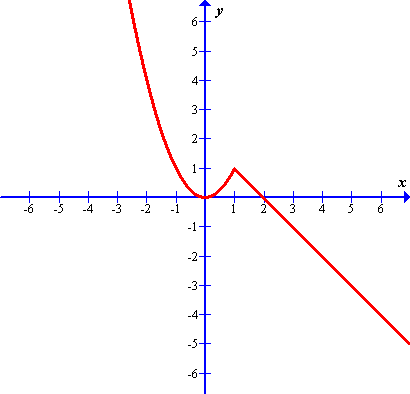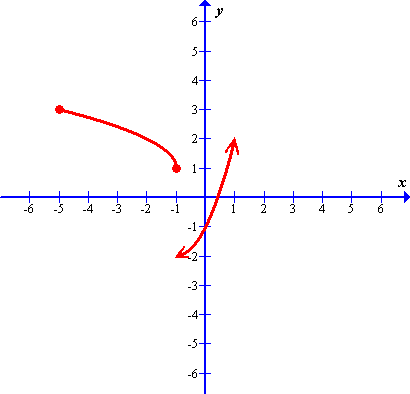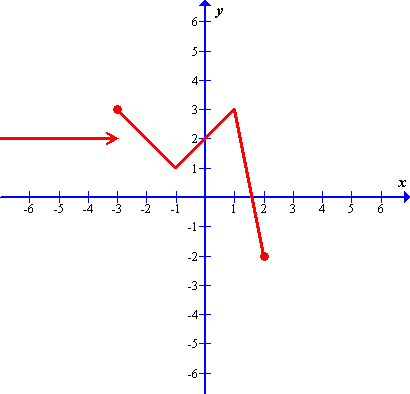
(a) \(f(x)=\sqrt{x+2}\)
(b) \(f(x)=\sqrt{2x-3}\)
(c) \(f(x)=\sqrt{6-2x}\)
Solutions: (a) domain: \(x\geqslant -2\); (b) domain: \(x\geqslant \frac{3}{2}\); (c) domain: \(x\leqslant3\)(a) \(f(x)=\log_2 (x+3)\)
(b) \(f(x)=\log_\sqrt{5} (6-x)\)
(c) \(f(x)=\ln(5-2x)\)
Solutions: (a) domain: \(x\gt -3\); (b) domain: \(x\lt6\); (c) domain: \(x\lt \frac{5}{2}\)(a) \(f(x)=\sqrt{4-x^2}\)
(b) \({\displaystyle f(x)=\sqrt{\frac{1-x}{1+x}}}\)
(c) \({\displaystyle f(x)=\frac{2x}{x^2+2}}\)
Solutions: (a) domain: \(-2\leqslant x\leqslant 2\); (b) domain: \(-1\lt x\leqslant 1\); (c) domain: \(\mathbb{R}\)(a) \({\displaystyle f(x)=\frac{x+2}{x^2-x}}\)
(b) \({\displaystyle f(x)=\sqrt{\frac{x+5}{3}}}\)
(c) \(f(x)=\log_3 x + 1\)
Solutions: (a) domain: \(x\ne0,~ x\ne1\); (b) domain: \(x\geqslant -5\); (c) domain: \(x\gt 0\)(a) \(f(x)=x^2-2\)
(b) \({\displaystyle f(x)=\frac{1}{x^2+1}}\)
(c) \(f(x)=x^3-4x\)
Solutions: (a) range: \(y\geqslant -2\); (b) range: \(0\lt y\leqslant 1\); (c) range: \(\mathbb{R}\)(a) \(f(x)=e^x-2\)
(b) \({\displaystyle f(x)=\ln\frac{2-x}{2+x}}\)
(c) \({\displaystyle f(x)=\frac{x+1}{x-2}}\)
(d) \(f(x)=\sqrt[\scriptstyle 3]{x}\)
Solutions: (a) domain: \(\mathbb{R}\), range: \(y\gt-2\); (b) domain: \(-2\lt x\lt2\), range: \(\mathbb{R}\); (c) domain: \(x\ne 2\), range: \(y\ne 1\); (d) domain: \(\mathbb{R}\), range: \(\mathbb{R}\)(a) (b)
(b)
(a) \(f(x)= \left\{\begin{array}{cl} x^2; & \mathrm{for}~ x\leqslant 1 \cr 2-x; & \mathrm{for}~ x\gt 1 \end{array} \right.\)
(b) \(f(x)= \left\{\begin{array}{cl} 2^x; & \mathrm{for}~ x\lt 1 \cr x; & \mathrm{for}~ x\geqslant 1 \end{array} \right.\)
Solutions: (b)
(b)
(a) \(f(x)= \left\{\begin{array}{cl} -1; & \mathrm{for}~ x\lt -1 \cr x; & \mathrm{for}~ -1\leqslant x\leqslant 1 \cr 1; & \mathrm{for}~ x\gt 1 \end{array} \right.\)
(b) \(f(x)= \left\{\begin{array}{cl} -x; & \mathrm{for}~ x\leqslant 0 \cr \frac{\textstyle 1}{\textstyle x}; & \mathrm{for}~ x\gt 0 \end{array} \right.\)
(c) \(f(x)= \left\{\begin{array}{cl} x+1; & \mathrm{for}~ 0\lt x\lt 2 \cr 1; & \mathrm{for}~ x\geqslant 2 \end{array} \right.\)
Solutions: (a) domain: \(\mathbb{R}\), range: \(-1\leqslant y\leqslant 1\); (b) domain: \(\mathbb{R}\), range: \(y\geqslant 0\); (c) domain: \(x\gt 0\), range: \(1\leqslant y\lt 3\)(a) (b)
(b)
